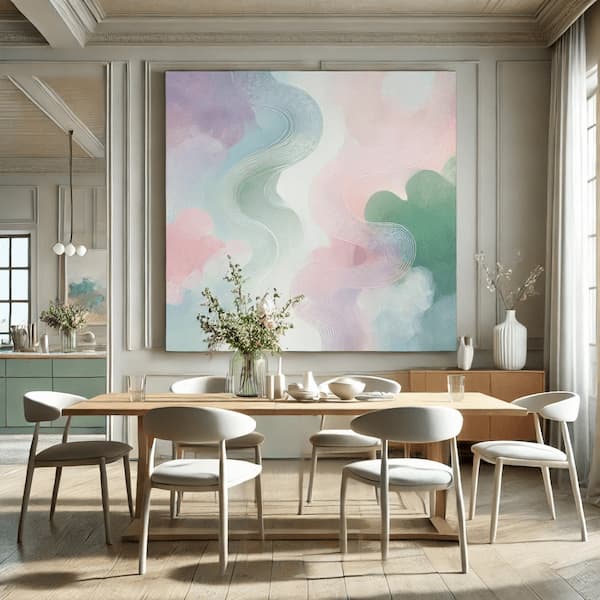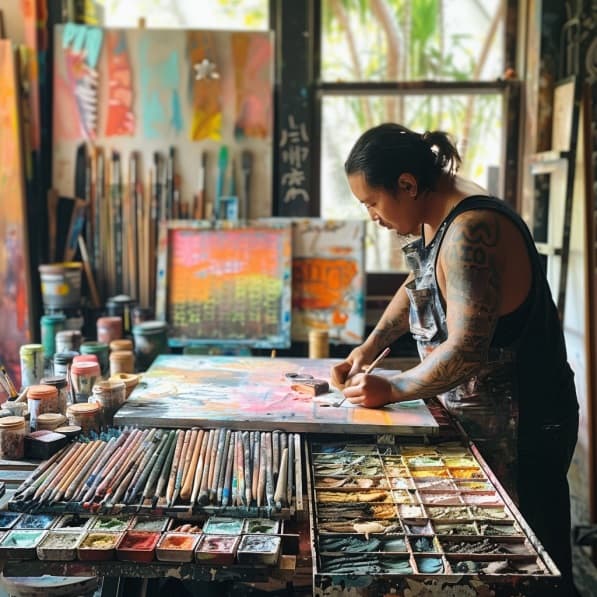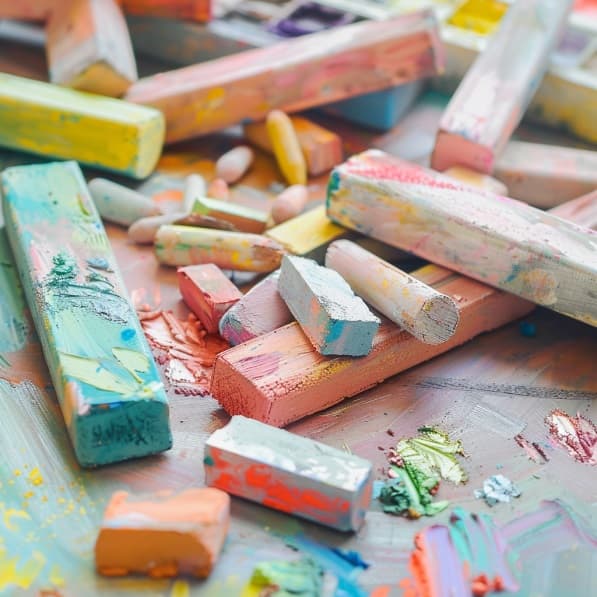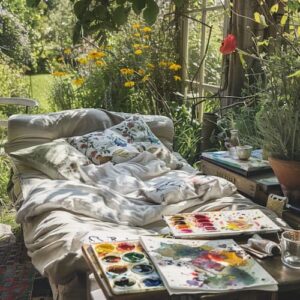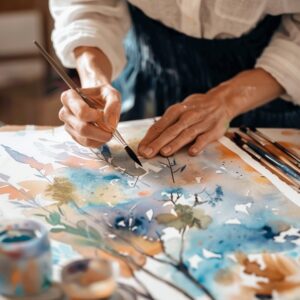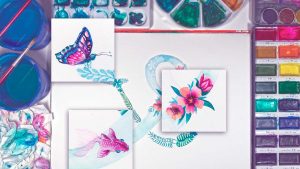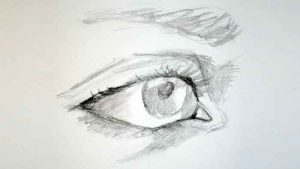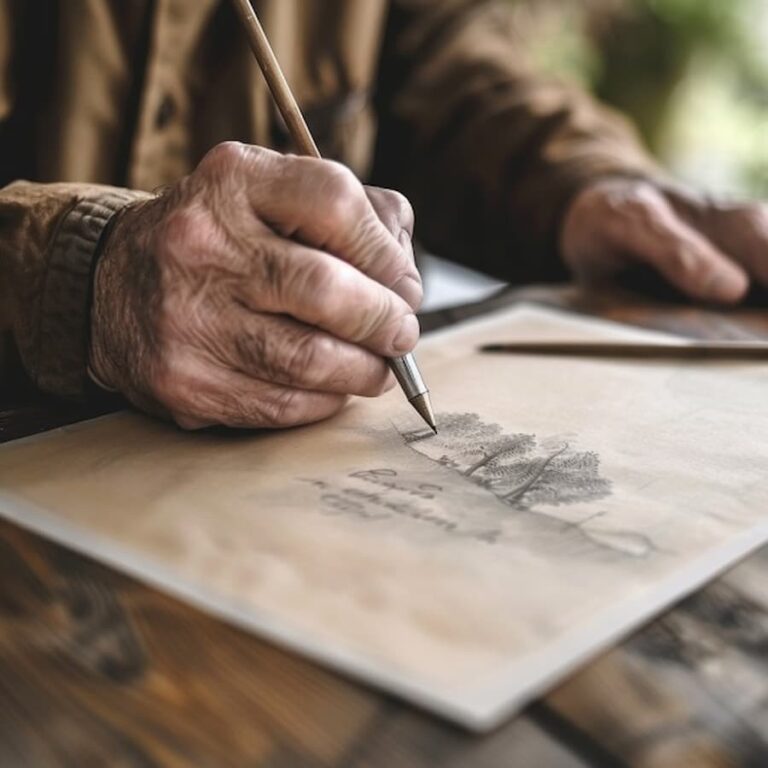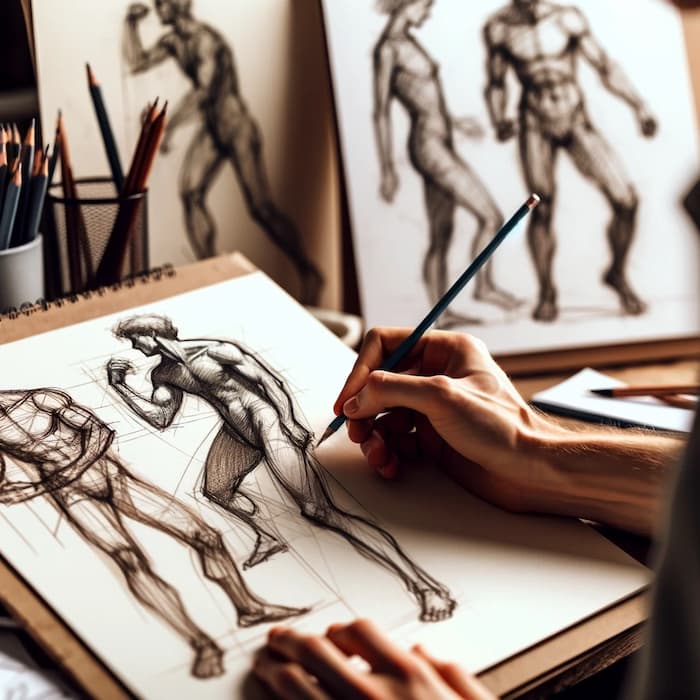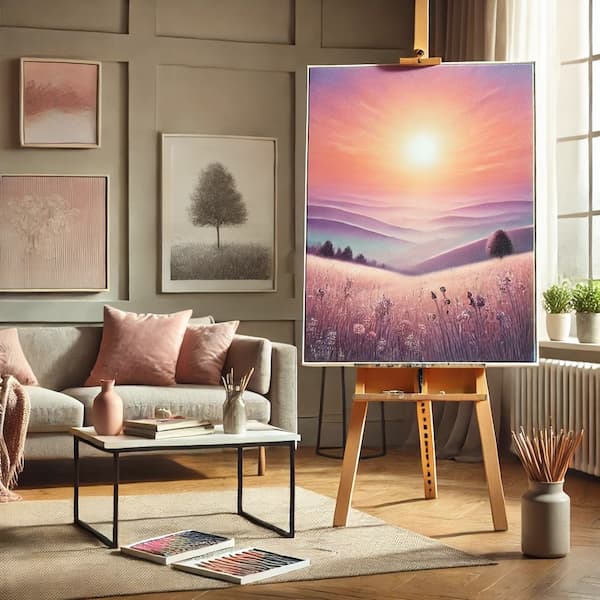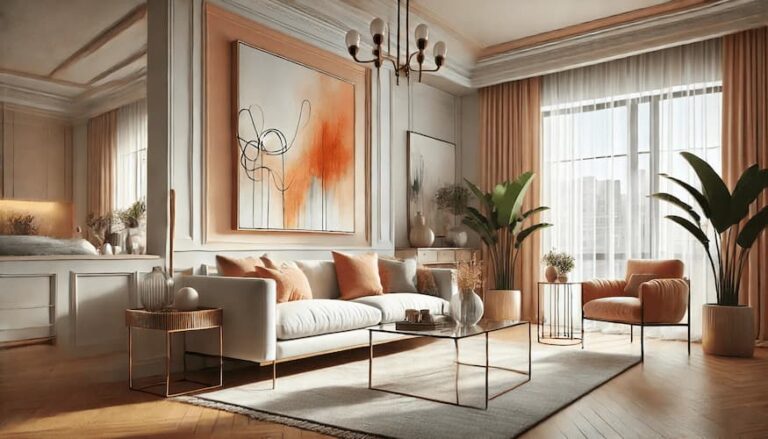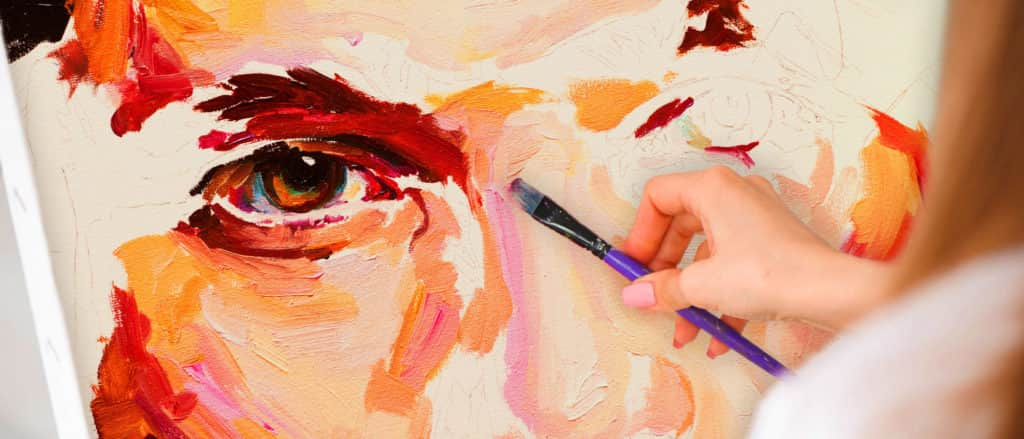Pastel painting is one of the most versatile and expressive artistic techniques.
In this article, we will explore the basics of pastel painting, from the choice of materials to the essential techniques for mastering this art.
Introduction to Pastel Painting
Pastels, known for their vibrant range of colors and textures, offer a unique experience for artists.
Unlike other mediums such as oil or watercolor, pastel combines the qualities of drawing and painting in a compact and accessible form.
But what makes pastel so special?
What are Pasteles?
Pastels are sticks of dry pigment that are mixed with a binder to hold their shape.
There are three main types of pastels:
- Dry Pastels: Include soft and hard pastels.
They are ideal for a wide range of techniques due to their ability to blend and blend easily. - Oil Pastels: Contain oils that give them a creamy texture.
They are perfect for thicker and layered effects. - Pastels in Bars: Combine characteristics of dry pastels and oil pastels, offering a balance between fluidity and texture.
Basic Principles of Pastel Painting
The first step in painting with pastels is to understand how the different types of pastels work and how they can be applied to various surfaces.
Materials Needed and Choice of Cakes
- Soft Pastels: They offer a wide variety of vibrant colors and are easy to blend.
However, their soft texture can be a challenge for beginners. - Hard Pastels: They are ideal for details and fine lines due to their firmer consistency.
- Oil Pastels: Provide a more robust finish and are excellent for layering and texturing.
Papers and Supports
The choice of paper is crucial to the success of a pastel painting.
Textured papers allow for better pigment adhesion.
Some of the most recommended include:
- Canson Mi-Teintes paper: Popular for its texture and variety of colors.
- Sand Paper: Offers a rougher texture, ideal for retaining several layers of cake.
- Pastelmat paper: Combines smoothness and texture, providing a unique surface to work on.
Other Materials
- Fixative: Used to fix the pastel and prevent stains.
- Diffusers or Tortillones: Tools for blurring and mixing colors.
- Gloves and Mask: To protect from cake dust.
Pastel Painting Techniques
Once you have your materials, it’s time to explore basic pastel painting techniques.
- Blurring Technique: Blurring is essential for creating smooth transitions and gradient effects.
You can blend with your fingers, a soft cloth, or a blender.
The key is to apply the pastel in light layers and blend to the desired softness. - Layering: The layering technique allows for depth and texture.
Start with lighter colors and work toward darker colors, applying each layer gently to avoid saturating the paper. - Texture Effects: To create texture, you can use techniques such as scratching or rubbing.
Scratching involves scraping off the top layer of pastel to reveal the color underneath.
Rubbing uses tools such as stiff brushes or spatulas to create patterns on the surface. - Color Blending: Color blending in pastels can be achieved in several ways.
One of the most common is to overlap layers of different colors and blend them.
You can also mix directly on the palette before applying to the paper.
Care and Conservation
Caring for your paints and materials is crucial to maintain their quality over time.
- Fixing the Work: Applying a fixative at the end of your work helps protect the pastel from smudging and wear.
Use spray fixatives in a well-ventilated area and with light coats to prevent colors from bleeding. - Storage: Store your paints in protective folders or frames with glass to avoid direct contact with the surface.
Upright storage is ideal to prevent pastel dust from accumulating. - Material Maintenance: Keep your cakes organized and clean.
You can use a box with compartments and a soft cloth to wipe off dust residue.
Tips and Tricks for Beginners
-Practice Light Hand
Light pressure when applying the pastel allows for smoother layers and better blending possibilities.
Avoid pressing too hard, as this can saturate the paper and make correction difficult.
-Experiment with Textures
Don’t limit yourself to using only your fingers to blend.
Try different tools such as brushes, sponges, and blenders to see how they affect the texture and appearance of the cake.
-Use Color Strategically
Choose complementary colors to create contrast and analogous colors for smooth transitions.
Experiment with color combinations to discover new palettes.
-Learn from the Masters
Look at works by well-known artists who use pastel for inspiration and to learn new techniques.
Looking at how they handle light, color, and texture can offer valuable insights.
-Keep your work area clean.
Cake dust can be harmful if inhaled in large quantities.
Be sure to work in a well-ventilated area and regularly clean your workspace.
Pastel painting offers an exciting opportunity to explore color and texture in a direct and tactile way.
With these basic principles, you’ll be well on your way to mastering this technique and creating vibrant, dynamic works of art.
To learn how to work with pastels like a real professional, knowing all its characteristics, use of materials and how to get the most out of this technique, visit our Painting Course with Lifetime Access + Workshops.
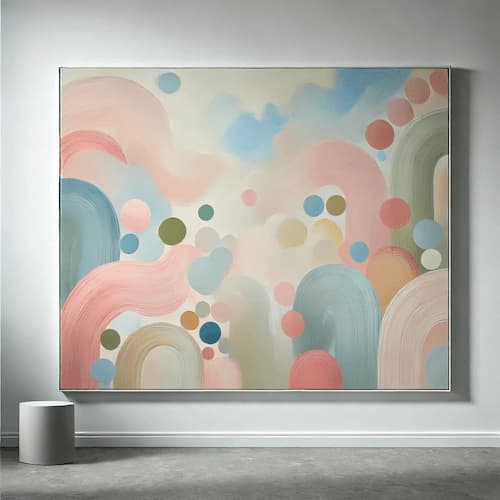
¿Cómo Elegir el Cuadro Abstracto en Tonos Pastel Perfecto?
Seleccionar el cuadro abstracto en colores pastel adecuado puede parecer una tarea desafiante debido a la variedad de opciones disponibles. Sin embargo, siguiendo algunos criterios simples, puedes asegurarte de encontrar la pieza perfecta para tu hogar o espacio de trabajo.
Considera el Tamaño y el Espacio
El primer factor que debes tener en cuenta es el tamaño del cuadro y el espacio donde será colocado. Un cuadro abstracto en tonos pastel de gran tamaño puede ser una excelente pieza central para una sala de estar o una oficina. Por otro lado, piezas más pequeñas pueden funcionar bien en áreas como pasillos o habitaciones más íntimas.
Escoge Colores que Complementen tu Decoración
Es importante que los colores del cuadro abstracto en tonos pastel se complementen con la decoración existente de tu espacio. Los colores suaves como el azul claro o el rosa pueden combinar bien con muebles de madera clara o paredes blancas, mientras que el verde menta o lavanda pueden aportar un toque de frescura a un entorno más neutro.
Ten en Cuenta la Emoción que Quieres Transmitir
Cada cuadro abstracto en pastel tiene el potencial de evocar una emoción particular. Los tonos pastel, en especial, tienden a generar una sensación de calma y paz. Si deseas crear un ambiente relajante en tu hogar o espacio de trabajo, los cuadros abstractos en colores pasteles son una excelente opción.
Beneficios de Incorporar Cuadros Abstractos en Tonos Pastel en la Decoración
El arte abstracto en tonos pastel no solo es estéticamente agradable, sino que también ofrece varios beneficios tangibles para el ambiente en el que se encuentra.
Crean Ambientes Relajantes
Los cuadros abstractos en tonos pastel son conocidos por su capacidad para transformar un espacio en un entorno tranquilo y relajante. Los colores suaves reducen el estrés visual, lo que hace que sean ideales para lugares donde se desea fomentar la calma, como dormitorios, salas de estar o áreas de meditación.
Aportan una Sensación de Amplitud
Al usar colores pastel, especialmente en piezas abstractas grandes, se puede dar la impresión de que una habitación es más amplia de lo que realmente es. Los cuadros abstractos en tonos pastel claros tienden a reflejar más luz, lo que puede hacer que el espacio parezca más luminoso y abierto.
Versatilidad y Adaptabilidad
Otra ventaja de los cuadros abstractos en color pastel es su capacidad para adaptarse a prácticamente cualquier estilo de decoración. Ya sea que tu hogar siga un estilo moderno, nórdico o incluso vintage, un cuadro abstracto en colores pasteles siempre encontrará su lugar. Además, estas piezas son fáciles de combinar con otros elementos decorativos, como cojines, alfombras o cortinas en tonos complementarios.
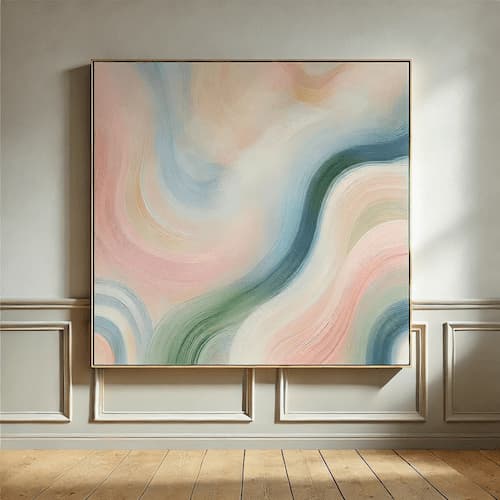
Cómo Integrar Cuadros Abstractos Tonos Pastel en tu Hogar
Una vez que hayas seleccionado un cuadro abstracto en tonos pastel, es importante que lo integres de manera efectiva en tu espacio para maximizar su impacto visual y emocional.
Crea una Pared Galería con Cuadros Abstractos en Tonos Pastel
Una tendencia popular en decoración es la creación de una pared galería. Al combinar varios cuadros abstractos en tonos pastel, puedes crear una composición única que añada personalidad a tu espacio. Juega con diferentes tamaños y formas para lograr un efecto dinámico.
Coloca Cuadros Abstractos Pastel en Espacios de Descanso
Los cuadros abstractos en pastel son ideales para áreas donde se busca relajación, como dormitorios o salas de lectura. Colocar un cuadro con tonos suaves sobre la cama o en una pared cerca de un sillón de lectura puede transformar el ambiente.
Combina Arte Abstracto con Elementos Naturales
Los cuadros abstractos en colores pasteles combinan muy bien con elementos naturales como plantas, madera clara o textiles suaves. Este tipo de combinación refuerza la sensación de calma y conexión con la naturaleza, creando un espacio acogedor y armonioso.
Para aprender a trabajar con pastel como un auténtico profesional, conociendo todas sus características, uso de materiales y cómo sacarle el máximo partido a esta técnica, visita nuestro Curso de Pintura con Acceso Vitalicio + Talleres.

